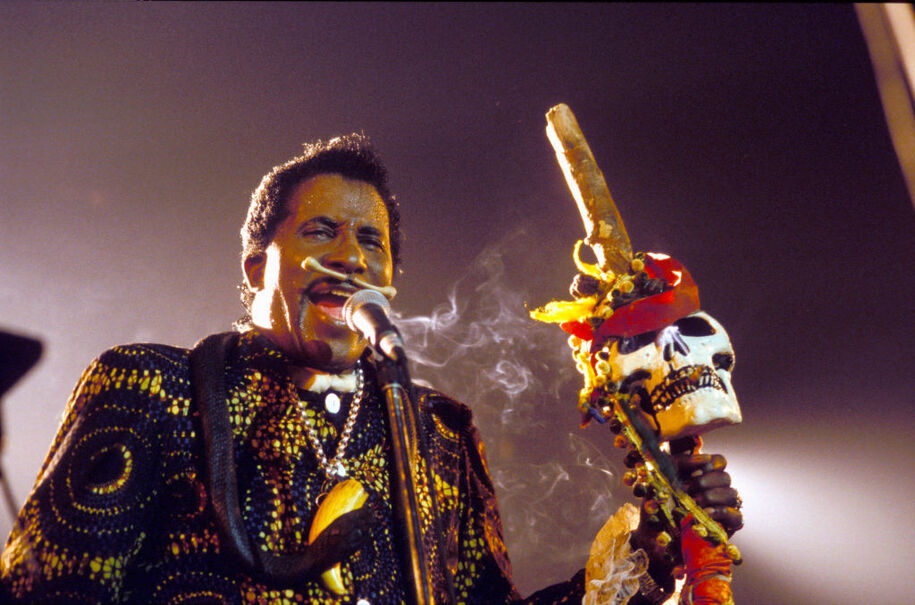Boo! It’s that time of year again, when Halloween is celebrated with ghosts, goblins, Jack-o’-lanterns, and all things spooky in neighborhood decorations and trick-or-treating costumes.
Here’s a jazz, blues, and R&B soundtrack to accompany you and get you into the mood as you make your preparations.
”Black Music Sunday” is a weekly series highlighting all things Black music, with over 230 stories covering performers, genres, history, and more, each featuring its own vibrant soundtrack. I hope you’ll find some familiar tunes and perhaps an introduction to something new.
One of the earliest hit jazz tunes about a ghost, was “swung” by the late great band leader, singer, and entertainer Cab Calloway. Calloway had already sung the tale of “Minnie the Moocher,” in 1931, which became his signature song, and was “the first musical recording by a black artist to sell 1 million records.”
SpookySongs.com tells the tale:
Bandleader Cab Calloway adapted a prior vaudeville hit called “Willie the Weeper” into a story about Minnie called “Minnie the Moocher“, most known for its “hi-de hi-de hi-de ho!” scat-singing. This became one of the biggest hits of the 1930s. Interestingly, the song is about Minnie and her friend (or dealer?) Smokey (who is a cocaine addict), and how they start smoking opium, and she dreams of a better life.
[…}
in 1939, we finally get to “The Ghost of Smokey Joe”. We learn that ol’ Joe has died, on Striver’s Row in Harlem. His ghost is haunting the old opium dens that he and Minnie used to frequent – but we find out that Minnie has cleaned up! Joe has to get back to his punishment in Hell(!), where he patiently waits for Minnie.
I got a date on my estate down in Hades /
Call my chariot so I can go /
And should the Moocher walk in /
Just tell her you’ve been talkin’ /
To the ghost of Smokey Joe
Pennies From Heaven was Armstrong’s first major screen appearance. At the insistence of star Bing Crosby, his turn as a mathematically-challenged bandleader snagged him a main title credit, a first for an African-American actor appearing opposite whites.
The role itself is not a pillar of race advancement, but Ricky Riccardi, the Armstrong House’s Archivist notes that Armstrong remained fond of the work, reenacting an entire scene from memory when he and Crosby appeared as guests on the David Frost Show in 1971.
Riccardi analyzes the song in his Wonderful World of Louis Armstrong blog:
Armstrong gets one music number to himself in the film and it’s a great one. “The Skeleton in the Closet” was written by Arthur Johnston and Johnny Burke, the same two men wrote the rest of the Pennies From Heaven score. Film in California, Armstrong was seen leading a contingent of some of the finest west coast jazzmen, including trumpeter (and Armstrong disciple) Teddy Buckner, saxophonist Caughey Roberts, future Nat Cole bassist Wesley Pince and as already advertised, the grand reunion of Armstrong and Lionel Hampton.
Hampton was in the midst of a steady engagement as a leader at the Paradise Nightclub in Los Angeles and was just about to explode. Pennies From Heaven was filmed in August 1936 and while out there, Armstrong asked Hampton to sit in on drums and vibes on two Hawaiian cuts made with “The Polynesians” on August 18. One week later, on August 24, Hampton took part in a Teddy Wilson session with Benny Goodman on clarinet and just a few months later, in November, Hampton joined Goodman’s Quartet and, well, you know the rest!
But for “Skeleton in the Closet,” Hamp sticks to the drums, wearing a mask to keep the whole “haunted house” motif going. This is Armstrong at his finest: storytelling, acting, singing, swinging and playing beautifully.
Here are the lyrics for anyone interested.
Armstrong also recorded the novelty tune “Spooks” in 1954, with arranger Gordon Jenkins and his orchestra and choir. There has been internet discussion about whether or not this tune was racist, considering the fact that Black folks were often labeled “spooks.” Frankly, I’m ignoring the negatives and enjoying the humor.
YouTuber Lindsay Holiday added “clips from Haunted House (1929) featuring Mickey Mouse” to Armstrong’s audio:
Speaking of spooks, my favorite tune about them comes from the great vocalese trio Lambert, Hendricks & Ross, from their 1961 album “High Flying,” written by Dave Lambert, with the song “Halloween Spooks.”
One of the most famous “spooky” songs and acts came to us from Jalacy “Screamin’” Jay Hawkins with his song “I Put a Spell on You.” Jay Gabler wrote for The Currant:
Born in Cleveland in 1929, Hawkins died in 2000 a cult figure forever associated with his signature song. “I Put a Spell On You” made Hawkins “Screamin’,” inspired his spooky stage schtick, and was covered hundreds of times; the best-known versions were by Nina Simone, Creedence Clearwater Revival, and Bette Midler (in the movie Hocus Pocus). Hawkins himself re-recorded the song several times, so that whatever else you were getting on a new Screamin’ Jay Hawkins album, you were likely also getting a new version of “I Put a Spell On You.”
The original, though, recorded and released in 1956, made Hawkins immortal. Even that version, for OKeh Records, wasn’t technically the original; the previous year he’d recorded a take for Grand Records, which didn’t put it out at the time. (It later surfaced on a rarities compilation.) The first version of the song, though, was relatively refined: forceful, but with the lid still firmly in place. OKeh producer Arnold Maxim, though, knew what Hawkins could do when he really let loose, and he thought “I Put a Spell On You” could be a vehicle for the full force of the singer’s unhinged delivery.
Here he is performing it live:
I have vivid memories of his act, which included a coffin. When I worked as a bartender in midtown Manhattan, Hawkins parked his coffin in a back room of the bar, and customers used to have their pictures taken lying in it. Hawkins also did a cover of Tom Waits’ tune, “Whistlin Past the Graveyard” in 1994.
In the late 1950s, Jones also released his first records as a leader. Blues for Dracula from 1958 includes Jones’s best Bela Lugosi imitation, and features cornetist Nat Adderley and saxophonist Johnny Griffin.Drums Around the World from 1959 features a super group of Cannonball Adderley, Lee Morgan, Benny Golson, Blue Mitchell, and Curtis Fuller. Also from 1959, Showcase is a superb date featuring many Jones compositions performed by the frontline of trumpeter Blue Mitchell, baritone saxophonist Pepper Adams, and trombonist Julian Priester.
Bobby Pickett, was not Black, however there there is a clear-cut Black connection in his hit tune “Monster Mash”:
Esquire culture editor Matt Miller wrote:
Okay, so let’s unpack this story. The narrator is simply describing the origin of this “Monster Mash” craze as he witnessed it. Nowhere does he confirm that the song we’re hearing—that he’s performing—is the same “Monster Mash” that he saw that fateful night. Throughout his story, he never provides any clear description of either a dance or the song—leaving the actual concept of the “Monster Mash” pretty ambiguous. We know it’s a graveyard smash, we know the zombies were having fun, we know at one point The Crypt-Kicker Five “played the mash”—but are bereft of any deeper details. All of this leads me to the assumption that we’ve never actually heard or seen this “Monster Mash.”
Desperate for answers, I reached out music legend Darlene Love, who sang backing vocals on the 1962 original version of Pickett’s song. At the time, Love had been performing with The Blossoms and got the call to sing background on a new song. They thought it was a hysterical throwaway song at the time—certainly not something that would still be beloved half a century later.
The concept for the song, as Love explains, clears up my first question. “Monster Mash” was released a few months after the smash hit “Mashed Potato Time,” which was then the song slash dance craze from Dee Dee Sharp. “We did the Mash, and you just did it a little more funnier and weirder by doing the mash, just doing the mash like Dee Dee Sharp did it,” as Love explains the dance. “They did the mash like they were monsters. They just did the mash, like the Mashed Potato. Only, they did with their arms flinging, and making all kinds of crazy moves. I think that’s the only way you can say that that was the Monster Mash.”
Closing with the question “Who you gonna call?” Most of you probably know the answer is Ray Parker Jr.’s “Ghostbusters” as Last.fm explains the history:
Ray Erskine Parker, Jr. (born May 1, 1954), is an American guitarist, songwriter, producer and recording artist. Parker is known for writing and performing the theme song to the motion picture Ghostbusters, for his solo hits, and performing with his band Raydio as well as the late Barry White.
[…]
Parker was one the first black artists to venture into the then-fledgling world of music videos. He actually made two different videos for his hit “The Other Woman”. The first was Halloween-themed and centered around a haunted castle with dancing corpses and vampires. The second was more performance-oriented, with Parker performing the song against a outer space background with backup singers. MTV initially refused to air either video because, at the time, no videos for black artists were shown and, in the case of the “haunted castle” video, Parker was depicted as having interracial relationships, which MTV didn’t want to promote.
“Ghostbusters” was a title track of the Gold-selling soundtrack of the hit movie Ghostbusters (but the song has now sold upwards of 28 million units internationally according to Parker in 2007), starring Bill Murray and Dan Aykroyd. The single was at #1 for three weeks on Billboard’s Hot 100 chart, and at #1 for two weeks on its Black Singles chart. The song was also nominated for an Academy Award for Best Original Song in 1984 but lost to Stevie Wonder’s “I Just Called to Say I Love You” from The Woman in Red.
Join me in the comments section below for more Halloween themed musical treats (no tricks) and please post some of your favorites.



